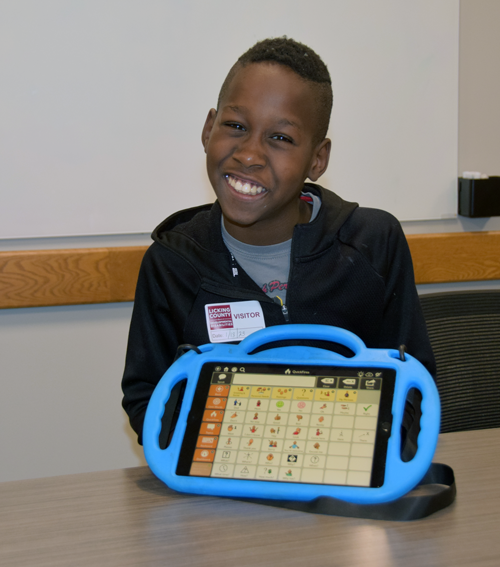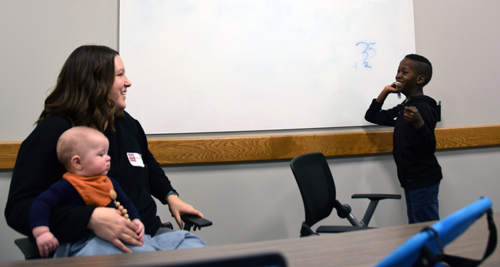- Fax- 740-322-6990
- 740-349-6588
- 800-325-2848
‘It’s had a huge impact on his life’

Meet Dawson!
December 5, 2022
Superintendent’s Message: Winter/Spring 2023
February 16, 2023There was a time when a missing shoe or a lost toy would cause tears and confusion for Caleb Kick and his parents, Amanda and Cory.
Caleb is deaf and primarily communicates using sign language. But when he’s frustrated or dealing with big emotions, it’s hard for him to put his thoughts into signs — which often left his parents guessing on what he needed.
But now, just by pressing a few buttons on his iPad, Caleb can ask his parents for help, communicate his feelings and advocate for himself.
“His iPad has changed things completely,” Amanda said. “It gives him so much agency.”
Caleb’s teachers at the Ohio School for the Deaf first brought up the idea of an iPad in 2019.
But at the time, he had only been living in the United States for about a year.
Before he was adopted by Cory and Amanda, Caleb and his younger sister Haddie, were living in orphanages in South Africa.
Although his orphanage knew he had cerebral palsy, they didn’t realize he was deaf until he was 5.
So he was starting a new school delayed in learning sign language, while also learning new words in English.
“He was climbing up a mountain in terms of language acquisition,” Amanda said.
During the COVID-19 pandemic, Caleb attended school virtually for 10 months. Once he returned to the classroom, the Kicks and his teachers decided to revisit the idea of assistive technology.
Using LCBDD Family Support Services (FSS) funds, Cory and Amanda started the process of working with their Service Coordinator to purchase the iPad, a case and the TD Snap Core First program for the device.
When the iPad arrived in the winter of 2022, Caleb took to it right away. It wasn’t long before he had created pages of words and phrases for all his favorite things, like math, soccer and video games.
But he also began using it to communicate when he was upset.
“The first time he got really mad, he asked for the iPad and he said, ‘Mad at Mom, mad at Dad!’ And we were ecstatic,” Amanda said. “That was the first time he was able to express that.”
Cory and Amanda helped him create a South Africa page, so he had words and pictures to talk about his past. This led to an amazing discovery.
When Caleb was first adopted, Cory and Amanda decided to use his middle name, Ben. But using his iPad, he was able to tell his parents that he was “finished” with the name Ben and wanted to go by his first name.
“That could have taken a long time and been very frustrating to try to figure out,” Amanda said. “The iPad was so helpful, it helped us to be sure that it was what he wanted.”
Caleb will always use sign language and is learning new words all the time, but the iPad has helped open his world, especially in communicating with people who don’t know how to sign.
This summer they plan to work on using the iPad so Caleb can help check out at the grocery store and order his own food at restaurants.
“Our goal for him is to understand how to use it with everyone to get what he needs,” Amanda said.
The Kicks are also looking at using a simple piece of assistive technology for Haddie, such as a button switch, so she can have more ways to express herself more in kindergarten.
After Caleb’s experience with the iPad, Amanda said she and Cory are much more aware and excited about the assistive tech options available to their children.
“The biggest thing we learned is not counting out ways for our kids to communicate or do things,” She said. “Years ago we wouldn’t have thought it would work, but it’s had a huge impact on his life. Just be open to letting your kids lead the way, especially with tech solutions.”






